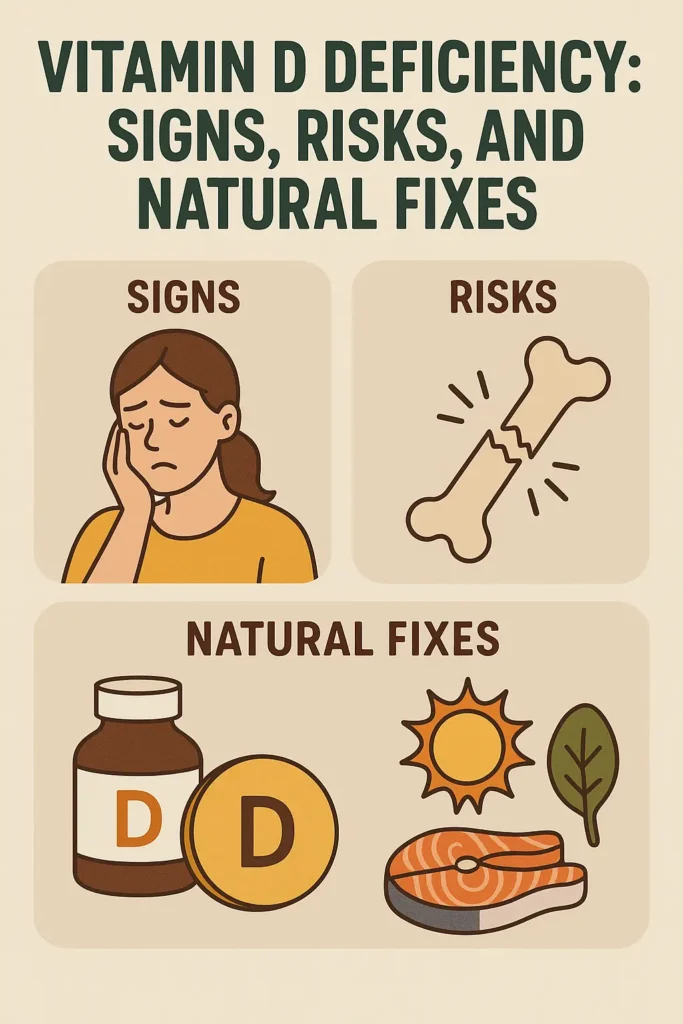- Vitamin D Deficiency: Unmasking the Signs, Understanding the Risks, and Embracing Natural Fixes
Vitamin D Deficiency: Unmasking the Signs, Understanding the Risks, and Embracing Natural Fixes
In today’s fast-paced world, it’s easy to overlook something as fundamental as a vitamin. Yet, one particular nutrient, Vitamin D, plays a surprisingly crucial role in our overall health. Often dubbed the “sunshine vitamin,” its deficiency is far more common than you might think, silently impacting millions. So, how do you know if you’re lacking? What are the potential consequences? And most importantly, how can you naturally boost your levels? Let’s dive in.
Are You Getting Enough Sunshine? Unmasking the Signs of Vitamin D Deficiency
Vitamin D is unique because our bodies can produce it when exposed to sunlight. However, various factors like geographical location, time of year, skin pigmentation, and even sunscreen use can limit this natural production. When levels are low, your body might send out subtle (or not-so-subtle) signals. Here are some common signs to watch out for:
- Persistent Fatigue and Tiredness: Feeling constantly drained, even after a good night’s sleep, can be a major indicator.
- Bone and Back Pain: Vitamin D is essential for calcium absorption and bone health. Chronic aches, especially in your bones or lower back, could signal a deficiency.
- Muscle Weakness and Aches: You might experience generalized muscle pain, weakness, or even cramps.
- Frequent Illnesses: A weakened immune system is a hallmark of low vitamin D. You might find yourself catching colds and flu more often.
- Depressed Mood: Studies have linked low vitamin D levels to an increased risk of mood disorders and depression.
- Impaired Wound Healing: Slow healing of cuts and bruises can also be a sign.
- Hair Loss: While many factors contribute to hair loss, severe vitamin D deficiency can be one of them.
If you experience several of these symptoms, it’s wise to consult your doctor for a simple blood test to check your vitamin D levels.

Beyond the Bones: The Far-Reaching Risks of Low Vitamin D
While vitamin D’s role in bone health is well-known, its influence extends far beyond that. Chronic deficiency can significantly increase your risk of developing a range of health issues:
- Osteoporosis and Fractures: This is the most direct consequence, as insufficient vitamin D leads to poor calcium absorption, making bones brittle and prone to fractures.
- Weakened Immune System: This is a critical point. Vitamin D plays a vital role in modulating the immune system, helping it fight off infections and regulate inflammatory responses. Low levels can leave you more vulnerable to autoimmune diseases and infections.
- Increased Risk of Certain Cancers: Research suggests a potential link between vitamin D deficiency and an increased risk of some cancers, including colorectal, breast, and prostate cancer.
- Cardiovascular Disease: Some studies indicate that low vitamin D levels may contribute to an increased risk of heart disease and high blood pressure.
- Diabetes: There’s growing evidence linking vitamin D deficiency to an increased risk of developing type 2 diabetes.
- Autoimmune Diseases: Vitamin D’s immune-modulating properties mean that deficiency can be a risk factor for autoimmune conditions like multiple sclerosis, rheumatoid arthritis, and lupus.
- Cognitive Decline: Emerging research suggests a connection between low vitamin D and cognitive impairment, particularly in older adults.
Naturally Boosting Your Vitamin D: Sunlight, Supplements, and Savory Foods
The good news is that addressing vitamin D deficiency often involves embracing natural strategies.
1. Embrace the Sun: Your Primary Source
Sunlight is undoubtedly the most efficient way to get your vitamin D. When UVB rays hit your skin, they trigger the production of vitamin D.
- Optimal Exposure: Aim for 10-30 minutes of midday sun exposure several times a week, exposing a good portion of your skin (arms, legs, back) without sunscreen. The exact duration depends on your skin type, geographical location, and the time of year.
- Be Mindful of Sun Safety: While crucial for vitamin D, always balance sun exposure with skin cancer prevention. Avoid sunburn, and use sunscreen during prolonged exposure.
- Consider the Season: In many parts of the world, especially during winter months, the sun’s angle is too low for effective vitamin D production.
2. Dietary Delights: Foods Rich in Vitamin D
While sunlight is king, certain foods can contribute to your daily intake.
- Fatty Fish: Salmon, mackerel, tuna, and sardines are excellent sources of natural vitamin D.
- Cod Liver Oil: This traditional supplement is packed with vitamin D (and Vitamin A!).
- Fortified Foods: Many dairy products (milk, yogurt), plant-based milks, cereals, and orange juice are fortified with vitamin D. Check the labels!
- Egg Yolks: A small amount of vitamin D is found in the yolk of an egg.
- Mushrooms (UV-exposed): Some mushrooms, when exposed to UV light, can produce vitamin D2. Look for “UV-treated” on the label.
3. Strategic Supplementation: When Nature Needs a Helping Hand
If natural methods aren’t enough, or if your deficiency is significant, your doctor may recommend vitamin D supplements.
- D3 vs. D2: Vitamin D3 (cholecalciferol) is generally considered more effective at raising blood levels than vitamin D2 (ergocalciferol). Most supplements contain D3.
- Dosage: Always follow your doctor’s recommendations for dosage. Over-supplementation can be harmful.
- Regular Monitoring: If you’re taking supplements, your doctor will likely want to monitor your vitamin D levels periodically to ensure they are within a healthy range.
The Immunity Connection: Low Vitamin D and Your Body’s Defenses
The link between low vitamin D and immune health is a burgeoning area of research. Vitamin D receptors are found on various immune cells, including T cells and B cells, which are crucial for fighting off pathogens. It helps:
- Modulate Immune Responses: Vitamin D helps prevent an overactive immune response (which can lead to autoimmune conditions) while also ensuring a robust defense against invaders.
- Enhance Antimicrobial Activity: It can stimulate the production of antimicrobial peptides that help destroy bacteria and viruses.
- Reduce Inflammation: Vitamin D has anti-inflammatory properties, which can help regulate the body’s inflammatory response to infection.
This explains why individuals with sufficient vitamin D levels often experience fewer and milder infections.
Taking Charge of Your Health
Vitamin D deficiency is a widespread issue with significant implications for your overall health, from bone density and mood to your immune system’s resilience. By understanding the signs, recognizing the risks, and actively incorporating sunlight exposure, dietary sources, and potentially supplements into your routine, you can naturally optimize your vitamin D levels and unlock a wealth of health benefits. Don’t hesitate to speak to your healthcare provider to assess your individual needs and create a personalized plan to keep your “sunshine vitamin” levels shining bright.


